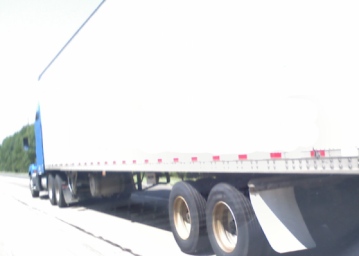
Big Rig Tires - Should You Buy New Tires or Retreaded Tires
Are you abusing your big rig tires and costing yourself a lot of money since tire replacement is ranked as the number three expense associated with operating a big rig. If you are just thumping your tires instead of at least air guaging them weekly and not performing the needed tire inspection / maintenance, the tire industry sends their thanks by selling you more tires than should typically be required. Underinflating, mismatching duals and overloading tires all contribute to you pulling out the big bucks and giving someone else your profits when you prematurely have to buy new tires. Even failure to service the front end of a big rig's king pins and bearings can result in your truck tires wearing out thousands of miles earlier than the manufactuer estimated. How Often Do I Need To Replace My Big Rig Tires?Barring the unfortunate nail and other tire piercing objects or your personal decision to neglect the required tire maintenance, normal tread wear is calculated to be 1/32nd of an inch "per every 13,000 miles traveled". Knowing this wear factor and the Federal Motor Carrier Requirements below, you can roughly estimate when to expect to replace the tires on your tractor and trailer. For the front steering wheels of your big rig tractor, Paragraph "b" of the Federal Motor Carrier Safety Regulation Title 49 Part 393.75 states that "Any tire on the front wheels of a bus truck, or truck tractor shall have a tread groove pattern depth of at least 4/32 of an inch when measured at any point on a major tread groove. The measurements shall not be made where tie bars, humps or fillets are located." Paragraph "c" of the Federal Motor Carrier Safety Regulation Title 49 Part 393.75 states that "Except as provided in paragraph (b) of this section, tires shall have a tread groove pattern depth of at least 2/32 of an inch when measured in a major tread groove. The measurement shall not be made where tie bars, humps or fillets are located." Can retreaded, regrooved or recapped tires be placed on front wheels or steering axles of big rig tractors?
While the use of recapped or retreaded tires on the front of your big rig is apparently not prohibited based on the Federal Motor Carrier Safety Regulation Title 49 Part 393.75 requirements, BigRigCentral.com will always recommend installing new tires only on the steering axles of big rigs. Sometimes saving money has to take a back seat especially when it comes to getting you back home safely to your family.
Tire Maintenance Tips:
Should You Buy Retreaded or New Big Rig TiresExcept for where the Federal Motor Carrier Safety Regulations state otherwise, the choice is entirely up to the owner operator or a trucking purchasing manager. According to the EPA waste conservation guide lines "In most situations, retread tires can be driven under the same conditions and at the same speeds as new tires with no loss in safety or comfort. In fact, retread tires have been safely used on school buses, trucks, cars, fire engines, and other emergency vehicles for years. Retreading tires also helps conserve a valuable nonrenewable resource-oil. Every year, retreading saves more than 400 million gallons of oil in North America. Retread tires also help divert thousands of scrap tires from disposal each year." It takes 7 gallons of oil to retread a truck tire compared to 22 gallons to manufacture a new one which results in retreaded tires typically costing 50 to 70 percent less than new tires. The better brands of retreaded tires are known to be offered with warranties because the dependability and service output has increased to where the retreading companies proudly stand behind their products. With proper tire maintenance followed and you watching the tire wear to allow you to use the casings 2 to 3 more times, retreading the tires could mean getting 750,000 miles of service from your tires while allowing you to recapture 75% to 80% of your initial new tire investment. Eventually you will need to purchase new tires again unless you become a convert to purchasing retreaded tires when possible.
Crossing the desert or coming down a mountain road is not the best time to see part of your retreaded tire on the windshield of the car where the driver is blowing the horn and giving you the peace sign at the same time. Better quality minded tire retreading companies using new tire retreading processes will have to work hard to change their minds.
|
Contact Us Advertise With Us Privacy Policy Cookie Policy Terms of Service Disclosure Policy Ads Site Map |
©2007-2018BigRigCentral.com All Rights Reserved Worldwide


 Facebook
Facebook Twitter
Twitter Delicious
Delicious Google Bookmarks
Google Bookmarks Fark
Fark Stumbleupon
Stumbleupon Technorati
Technorati Yahoo My Web
Yahoo My Web